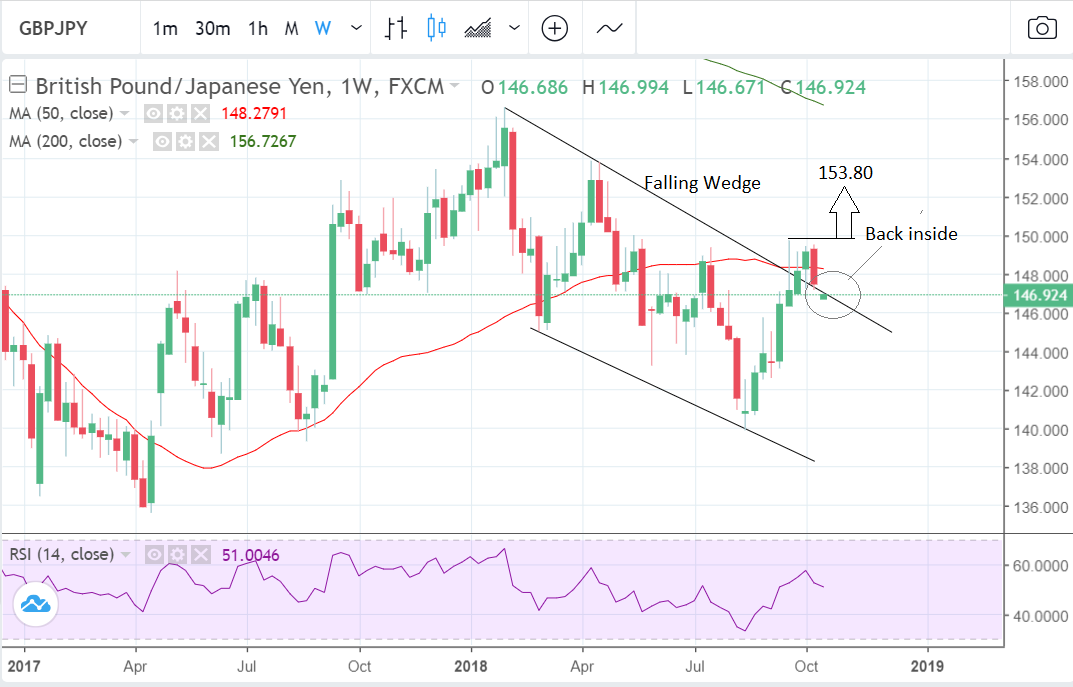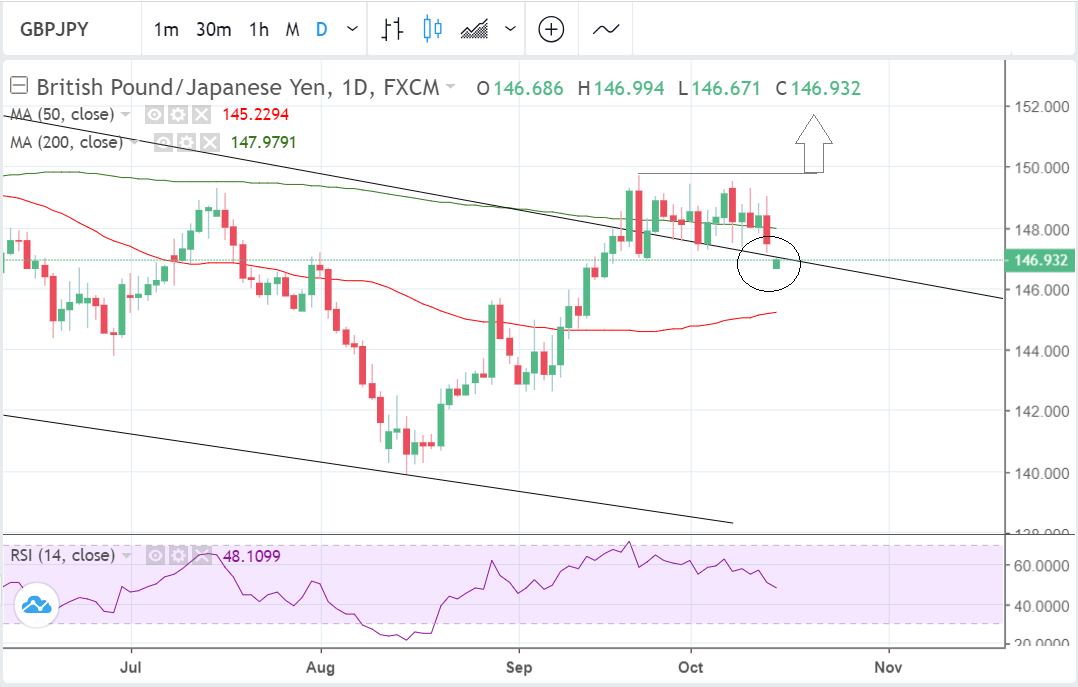Yen Forecast to Advance on Sterling Over Coming Days

Image © Adobe Stock
- GBP/JPY opens lower on Brexit breakthrough disappointment.
- Pair now facing a technical reversal that could take it even lower still.
- Brexit headlines to dominate GBP as JPY eyes domestic inflation data.
The Yen is on the front foot against the Pound after a series of adverse Brexit headlines and the overcrowded market bet against the Japanese currency suggests the GBP/JPY exchange rate could go lower still.
While it is too early to say the pair is set for further decline, the evidence is certainly growing that this could be the case.
The exchange rate gapped significantly lower at the start of the trading week and has fallen back inside the falling wedge pattern it was trading in before it broke out higher in September.
News that Brexit talks between the U.K. and EU have stalled due to disagreement over the Northern Irish backstop have taken the market by surprise after it was lulled into a false sense of security last week by repeated reports that a deal was supposedly just around the corner.

Above: Pound-to-Yen rate shown at daily intervals.
The original breakout from the wedge (above) was a strong bullish sign and indicated the exchange rate might surge higher however, the pair failed to follow-through and instead has traded sideways for several weeks. The lower open this week could mean a new and more bearish phase is beginning.
An extremely crowded market short position against the Yen indicates the Japanese currency is vulnerable to a pop higher too. When positioning reaches the extremes, either long or short, it leaves the market vulnerable to sudden changes in sentiment. It might not take much good news to encourage a rally in the Yen over coming days and weeks.
But it is still just too early to say the trend has reversed. For the dominant uptrend to be overturned we would want to first see the exchange rate move back inside the wedge pattern on a closing basis. This would then suggest the exchange rate is bearishly inclined, indicating the potential for a fall to the pattern lows close to 138.
As things stand, however, we continue to hold onto our bullish forecast, despite misgivings. This is conditional on a break above the 149.71 September high and could result in a move up to a target at 153.80.

Above: Pound-to-Yen rate shown at weekly intervals.
The Japanese Yen: What to Watch
The main release for the Yen in the week ahead is inflation data which is forecast to show consumer prices rising by 1.0% in September, up from 0.9% previously, when the number is released at 00.30 London time on Friday, 20 October.
A higher-than-expected result would be bullish for the Yen and vice-versa because rising inflation might prompt the Bank of Japan (BOJ) to consider changing its monetary policy.
The BoJ's quantitative easing and yield curve control programme are negative factors for the Yen because they keep interest rates low and so force investors to look for returns abroad, leading to increased capital outflows.
Trade balance data is out on Thursday and is forecast to show the trade deficit narrowing to -50bn, from -445bn Yen in September, due to an increase in exports. A deeper deficit tends to weaken the Yen while a surplus or deficit reduction can be supportive.
The other main release is industrial production growth for August, due on Monday at 05.30. This is forecast to show 0.7% growth, the same as in the previous month however, industrial production is expected to have contracted when output from the recent month is compared with that of one year ago.
Advertisement
Get up to 5% more foreign exchange by using a specialist provider to get closer to the real market rate and avoid the gaping spreads charged by your bank when providing currency. Learn more here
The Pound: What to Watch
Brexit headlines will continue to drive the Pound in the week ahead.
U.K. Brexit minister Dominic Raab will travel to Brussels on Monday for a meeting with E.U. chief negotiator Michel Barnier, probably to agree on the final proposals to put before E.U. leaders at their crunch summit on Wednesday, October 17-18.
The outcome of the summit is expected to be a key driver for the Pound in the week ahead. If there is concrete progress on a withdrawal deal Sterling is likely to surge higher; if, on the other hand, there is no progress the Pound will fall.
Analysts at FX broker XM are rather pessimistic about the possibility of a major breakthrough:
"As it is standard for all E.U. negotiations to last into the last minute, the remaining issues are unlikely to be resolved at the E.U. heads of government summit on October 17-18 and the talks will probably continue into November when a special summit is being planned."
XM adds that "a worst-case scenario would be for Prime Minister May to secure a deal that has little chance of getting approved by the British parliament."
Indeed, weekend headlines have been troubling for the Prime Minister with reports that the cabinet are being urged to stage a mutiny on May's plans.
The big problem lies with a backstop clause that would trigger if the E.U. and U.K. fail to reach a trade deal during the two year transition period. There is talk that the backstop could apply to the whole U.K. and not just Northern Ireland, as had been the original proposal.
It is believed that Prime Minister May is willing to allow this transition to last indefinitely; something fiercely opposed by Brexit supporting MPs in the Conservative party. Should a time limit be agreed the opposition to May might fade and she will be able to push legislation through parliament.
There are several major releases in the week ahead but probably the most important is broad inflation data in September, which is forecast to show a 2.6% rise compared to a year ago and a 0.2% rise compared to a month ago, when it is released on Wednesday at 9.30 B.S.T.
Core inflation, meanwhile, is forecast to show a 2.0% rise compared to a year ago.
Inflation informs central bank policy and, crucially for FX, whether they put up interest rates; these in turn impact on exchange rates. A higher-than-expected rise in inflation would increase pressure on the Bank of England to raise interest rates and support the Pound.
The other major release in the week ahead for the Pound is employment and wage data, out on Tuesday at 9.30.
The unemployment rate is expected to remain at 4.0% in August. Average pay excluding bonuses is expected to have climbed by 2.9%, and pay including bonuses to have increased by 2.6%.
Market participants will be particularly focused on whether pay has increased more than expected - if it has the Pound could rise - as this will raise the outlook for inflation.
The third major release for Sterling in the week ahead is retail sales out at 9.30 on Thursday.
Retail sales have been fairly resilient but in September they are forecast to show a -0.3% drop (from 0.3% in August) but, nevertheless, a 3.7% rise compared to September last year. A higher-than-expected result would probably support the Pound as it suggests greater growth, inflation, and higher interest rates which are usually favourable for a currency.
Finally the weekends with a speech by the governor of the Bank of England (BOE) Mark Carney on Friday, at 16.30, which has been earmarked by some as a possible time for the Uk authorities to announce progress on securing trade deal with the EU.
Advertisement
Get up to 5% more foreign exchange by using a specialist provider to get closer to the real market rate and avoid the gaping spreads charged by your bank when providing currency. Learn more here

